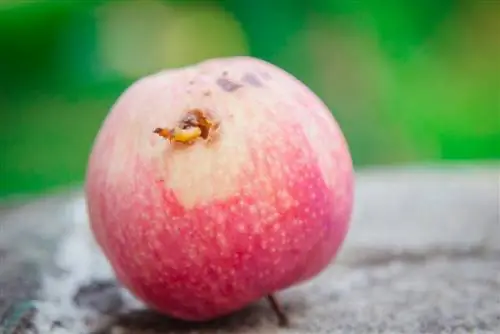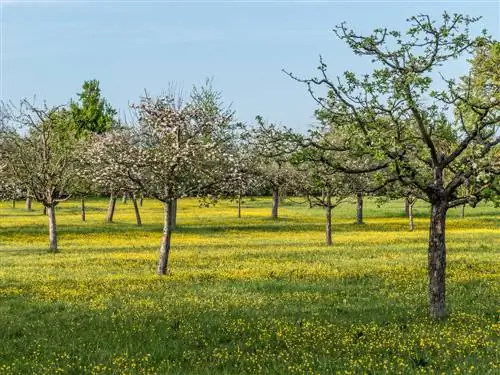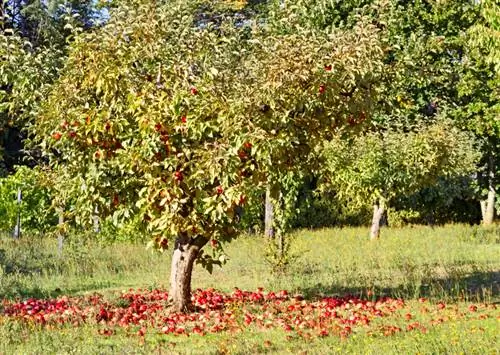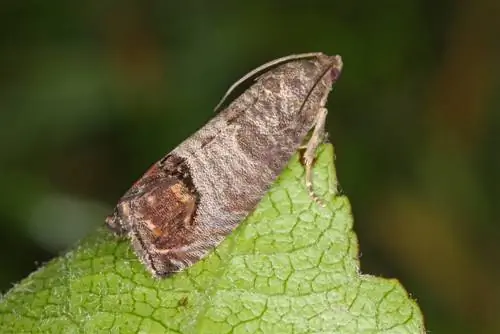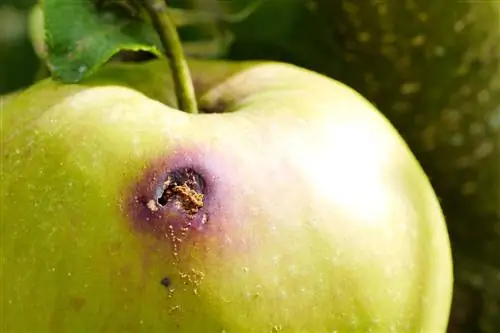- Author admin [email protected].
- Public 2023-12-16 16:46.
- Last modified 2025-01-23 11:21.
The proverbial worm in the apple is the larva of a butterfly, the codling moth (Latin: Laspeyresia pomonella). The dreaded pest spreads quickly and threatens to destroy entire crops. Fortunately, the butterfly and its voracious offspring can be easily controlled using biological measures.
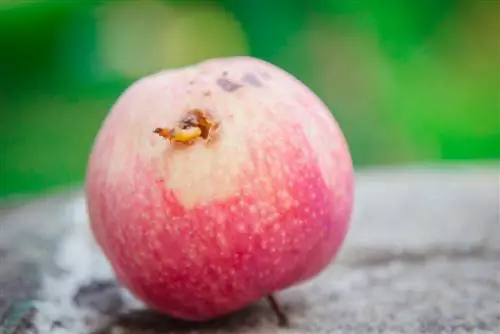
How can you combat the codling moth biologically?
The codling moth is a pest that eats the larvae in the peel of apples. Effective biological control measures include pheromone traps, granulose viruses and nematodes. Encouraging predators such as earwigs, bedbugs and parasitic wasps can also reduce infestations.
The shiniest apple contains the biggest worm.
malicious image
A codling moth infestation can be easily recognized by the holes only a few millimeters in size that the larva eats into the delicate shell of the unripe fruit. Typically it eats its way in a spiral from the outside inwards to the core casing, which is also affected. Feeding passages and the core are contaminated with brown piles of feces, both of which are clearly visible when cutting the apples. Apples that are infected early usually fall off early.
What can you do effectively against the codling moth?
In the event of an acute or impending codling moth infestation, biological or natural control methods are recommended, as chemical sprays also threaten the harvest - after all, these are toxins that you would later consume with the apples. In addition, many insecticides are generally not approved for use in home and hobby gardens.
Pheromone traps
Pheromone traps are less suitable for direct control of the codling moth, but they do provide a very good impression of the actual infestation. In addition, you capture the male butterflies, which are no longer able to fertilize the eggs of the female animals - so no offspring hatch.
Pheromones are sexual attractants that are painted into an adhesive trap coated with glue. The male butterflies confuse the scent with that of the females, stick and can then be collected. And this is how the system works:
- Time: from the beginning of May one trap per fruit tree
- Control: Treatment measures required from five moths per week
- Further measures: immediate injection with granulose viruses
By the way, you can ask your local plant protection office when the codling moths start laying their eggs.
Today I was out in an orchard and came across a pheromone trap for the codling moth. This reminded me of how I caught the pheromone dispensers and gave me the following thoughts. Plant protection products (PPM) are effective and easy to use. But what about other means of protecting plants? If you don't just want to rely on purely organic products, then integrated plant protection would be the best solution. This would make your own business more sustainable and environmentally friendly. Pheromone traps themselves are a very good method for combating and monitoring the number of pests such as the codling moth. With the confusion method, the communication system between male and female individuals of an insect species is directly disrupted. Applying a large-scale scent cloud with a pheromone ampoule confuses the male insects, reducing the size of the next generation. Just don't forget to change the traps in good time. alinaquality fruit growing apple moth pheromone trap integrated plant protection psm
A post shared by Alina Androsova (@alina_androsova_quality) on Jun 17, 2019 at 3:53pm PDT
Granulosevirus
However, the time window for treatment with granulose virus preparations such as Madex is very narrow, as you have to catch the newly hatched fruit maggots on their way to the apple. This migration only lasts a few days, which is why precise control of flight times using pheromone traps is so important. The flight peak is usually between mid-May and mid-June, which is why treatment with this biological agent is also carried out at this time.
Granulose viruses are effective against codling moths, but are harmless to bees and other beneficial insects - not entirely unimportant in fruit growing, after all, these insects are supposed to fertilize the apple blossoms. And this is how the preparations are used:
- Mix the preparation exactly according to the package instructions.
- Fill into a clean garden sprayer.
- Spray the entire tree carefully.
- Do not leave any corners untreated as the caterpillars have to absorb the active ingredient directly.
- Repeat the application three times at intervals of eight days.
- Also repeat from the end of July / beginning of August to catch the second generation.
Apply the treatment on a dry day when there is neither rain nor wind. Both have a negative impact on the result.
Nematodes
Nematodes of the type Steinernema feltiae have also proven to be effective against overwintering codling moth larvae. These are tiny roundworms that penetrate the larvae and kill them through a bacterial infection. And this is how the method works:
- Nematodes are sprayed after harvest.
- They are intended to reduce the infestation pressure in the coming year.
- Wet weather (drizzle) and temperatures above eight degrees Celsius are ideal.
- Do not spray on sunny days, if possible in the evening
- Nematodes are very sensitive to UV light
- spray all winter hiding places: trunk and branches, poles and sticks, fruit mummies)
How to prevent codling moth infestation
As is so often the case, the worst infestations can be prevented through targeted preventive measures. The basis for success is knowledge of the life cycle and biology of the codling moth in order to find the right time.
Encourage predators
One of the most important preventive measures is to encourage beneficial insects and birds, because they like to eat the codling moth - and many other pests. Make your garden bird-friendly, for example by hanging (cat-proof!) nesting boxes, setting up feeding stations in winter and setting up a bird bath in summer. Sparrows, various species of tits, blackbirds and other songbirds will be happy to settle with you.
When it comes to insects, these species in particular are effective predators of the codling moth:
- Earworms
- Bugs
- Parasitic wasps
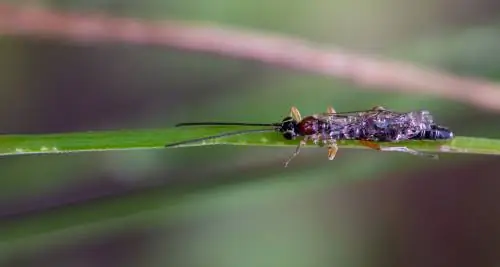
Parasitic wasps kill codling moths
In particular, the parasitic wasps of the species Elodia tragic, Ascogaster quadridentatus and Trichogramma enecator have proven to be good control agents. They are available from specialist retailers. The beneficial insects attach themselves to small cards that you simply hang between the branches of the apple tree. This should be done as early as possible in the year so that the infestation pressure does not become so great.
Minimize wintering places
In particular, the bark of older apple trees offers the codling moth perfect hiding places in winter. That's why you should treat them preventively:
- Scraping the bark: In late winter (January / February), treat the bark of the apple trees with a hard brush or a special metal bark scraper. Loosen the loose pieces of bark, but do not damage the bark.
- Corrugated cardboard catch belt: From the end of June, wrap a ten to 20 centimeter wide strip of corrugated cardboard around the trunk and secure it well. The caterpillars crawl underneath to pupate and can easily be collected.
- Traps on support posts: You should also attach the same rings to any support posts that may be present. Check the corrugated cardboard traps weekly and remove them completely from the end of September.
- Removing rotten support posts: Rotten support posts are also often used for wintering and should therefore be removed in autumn
In contrast to the frost moth, glue rings have no effect on the codling moth and are therefore not a suitable method for prevention or control. Instead, you can try this ancient farmer's trick, which also offers other advantages:

Collect larvae
Between January and April, regularly check the trunks of your apple trees for overwintering codling moth larvae or their pupae. Shake the trees because the animals will fall to the ground and can be collected. During the growing season, infected fruits should be removed as early as possible to prevent further development of fruit maggots.
Appearance of the codling moth
The adult butterfly is very small, only one centimeter long, and also has an inconspicuous coloring. The grey-colored cover wings (forewings) have wavy, dark transverse lines, and there is also a reddish-brown spot on the outer edge that is characteristic of the species. The slightly shiny hindwings are colored grey-brown. Male and female animals hardly differ from each other in appearance.
The whitish, individually laid eggs, which are only about a millimeter in size, initially hatch into whitish caterpillars up to two millimeters long. These change their appearance as they develop and later become pink and up to two centimeters long. The dark warts and the dark brown head and neck shield are also typical of older caterpillars. The brown doll, on the other hand, is also quite small at around eight to ten millimeters long.
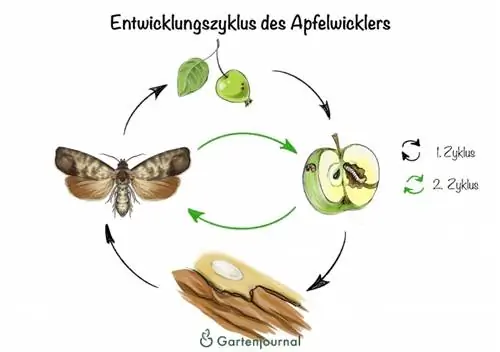
Similar looking pests
For countermeasures to be successful, the type of pest on the apple tree must be determined. There are some species that are quite similar to the codling moth in appearance and/or damage. However, some of these are combated with different means and/or at different times than this one. In the following table you will find an overview with clear distinguishing features.
| Art | Latin name | Characteristics | malicious image | Distinctive features of the codling moth |
|---|---|---|---|---|
| Plum moth | Laspeyresia funebrana | gray-brown butterfly with a wingspan of up to 15 mm, caterpillar up to 15 mm long and pink to bright red | bluish discoloration of the fruits, traces of feeding, rubber flow | copper-brown spot on the forewings, codling moth penetrates to the core |
| Peach shoot moth | Lapeyresia molesta | dark butterflies with a wingspan of up to 16 mm, caterpillars up to 14 mm long, whitish to reddish with a brown head capsule | feeding marks, rubber flow on infected fruit | copper-brown spot on the forewings, codling moth penetrates to the core |
| Small fruit moths | Grapholita lobarzewskii | up to 8 mm long butterfly with yellow-brown forewings and gray-brown hindwings, caterpillars up to 12 mm long, yellow-gray to light pink in color | Entry and exit holes in the fruits, with furrows, sometimes leaf miners | no fecal deposits in the fruit, does not penetrate into the core |
| dock sawfly | Ametastegia glabrata | Larva is green and has seven pairs of legs | uses apples for pupation | no feces crumbs in the holes, typical web |
| Apple sawfly | Hoplocampa testudinea | white-yellow larva with ten pairs of legs | clear traces of feeding up to the hollow point | Damage often up to the size of a walnut, affected fruits fall off |
Occurrence and distribution
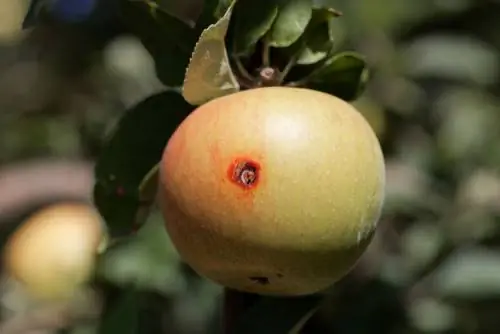
The codling moth prefers to eat apples, but not only
The codling moth - sometimes also called the apple moth - threatens fruit tree harvests almost all over the world. The species primarily attacks apple trees, but also affects pears, quinces, peaches and even walnuts. Depending on the region and therefore the climate, the pest goes through up to two generations per year and thus reproduces very quickly.
This is typical for the Lake Constance region, for example, but the codling moth is also appearing earlier and more frequently in other parts of Germany. This is due to the increasingly warm temperatures in spring and summer, which create ideal living conditions for the development of the butterfly. For example, the flight time has moved forward significantly as spring begins earlier and earlier with mild temperatures.
Life cycle and biology
The larva of the codling moth - which is also often referred to as the fruit maggot - hibernates under the bark of the apple tree, where it is embedded in a solid web. As soon as the temperatures are warm enough, usually from the end of April, the caterpillars pupate and emerge as adult moths from mid-May.
Just a little later, the females lay their 20 to 80 eggs in the still young fruits. Two weeks later, the first larvae hatch and go to the food source: The animals feed on the peel as well as the pulp and the seeds of the apple - the latter, by the way, is a clear indication of a codling moth infestation, as the larvae of other pests don't do this.
After three to four more weeks, the caterpillars have eaten enough and go to the trunk of the apple tree to ensconce themselves in the bark and hibernate there. The growth of the codling moth larvae is highly dependent on the temperature: if it is cooler than ten degrees Celsius, eggs and larvae do not develop. However, after a warm spring and summer, two or even three generations of the pest develop and cause enormous damage.
Harmful effects
The codling moth prefers apple trees of different varieties for egg laying and nursery - of course. However, the species can also be found on other types of fruit, especially in warmer climates. Those most at risk are:
- Apricots
- Pears
- Chestnuts
- Cherries
- Peaches
- Plums
- Quinces
- Walnut
- Hawthorn
If the weather conditions are so favorable in one year that the population and thus the infestation increase dramatically, this strong increase will continue over the next few years. During and after a warm, dry year, preventive and control measures must therefore be carried out with particular care.
Tip
Early affected fruits usually have to be sorted out, while late affected fruits can often be at least partially used. In this case, generously cut away the damaged areas in the apple. However, these fruits can no longer be stored.
Frequently asked questions
What is the confusion technique and how does it help against the codling moth?
The pheromone traps already mentioned serve to confuse people. Although these are well suited to timing the peak of the codling moth flight and thus the right time to spray, they only have a small influence on the population and thus the infestation pressure.
Can codling moth also be controlled with neem?
Neem is effective against many fruit pests, but not against the codling moth.
Are there effective home remedies for the codling moth?
Instead, you can use wormwood manure as a tried and tested home remedy. To do this, pour ten liters of water over 300 grams of fresh wormwood leaves and let the mixture ferment in a plastic container for ten to 14 days. Only fermented wormwood manure is effective against codling moth, but a simple infusion is not strong enough. To combat the strong smell, you can stir in a handful of rock dust. Spraying with wormwood must be carried out in spring between mid-May and mid-June and is best repeated several times.
Tip
For the wormwood manure, use dried herbs collected the previous year instead of fresh leaves. After all, you will hardly find suitable wormwood herb this early in the year.

